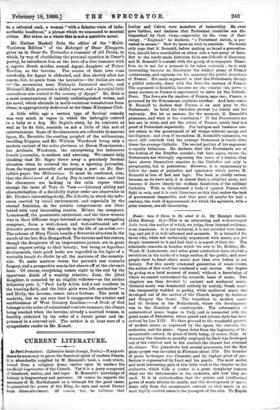Music: how it Came to Be what it Is. By
Hannah Smith. (John Murray. 6s.)—This is an interesting and well-arranged little book, the author of which, we judge, from internal evidence, is an American. It is not technical, it is not crowded with learn- ing, and yet it is well informed and accurate. It is intended for those who, while not technically acquainted with music, are yet deeply interested in it and feel that it is a part of their life. The admirable concerts in London which we owe to Dr. Richter, Mr. Wood, M. Lamoureux, and other great conductors have created a revolution in the tastes of a large section of the public, and more people want to know about music now than ever before in our history. For this newly awakened generation of music-lovers, the author of this work has rendered a real service. She begins by giving us a brief account of sound, without a knowledge of which we cannot understand the scientific basis of music. Two chapters are then devoted to ancient and mediwval music. Oriental music was dominated entirely by melody, Greek music was inseparably wedded .to poetry, while medieval music was developed out of the service of the Church largely by Ambrose and Gregory the Great. The transition to modern music had its theatre in the Netherlands, where the development was- in the direction of counterpoint. The reformation of ecclesiastical music began in Italy, and is connected with the great name of Palestrina, whose grand and solemn style has been revived by Leo XIII. We then proceed to the wonderful growth of modern music as expressed by the opera, the oratorio, the orchestra, and the piano. Opera dates from the beginning of the seventeenth century, its place of birth being, of course. Italy. In Germany the chorale so grandly employed by Bach was developed out of ths rakslied, and in the oratorio the chorale has attained its climax. The pianoforte had several precursors, but the first piano proper was invented in Florence about 1710. The founder of piano technique was Clementi, and its highest pitch of per- fection is represented by Liszt and his pupils. The most useful and most interesting part of this little work is the chapter on the• orchestra, which tells a visitor to a great symphony concert what are the instruments in the orchestra, and how they are used. It is in orchestration that the genius and intellectual power of music attains its zenith, and this development of music dates only from the seventeenth century, so that music in its most highly evolved sense is the youngest of the arts. To Haydn
we owe the origin of the symphony. Altogether, an excellent little work, with scarcely a line in it which is not intelligible to the average person with no technical knowledge.







































 Previous page
Previous page